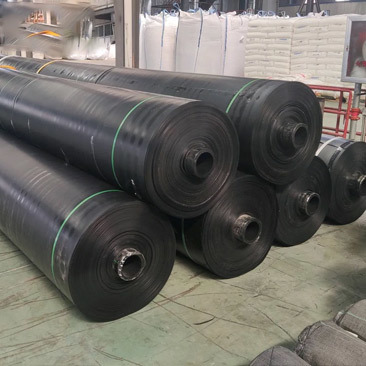How Geomembrane Enhances Site Safety and Durability
Release time:
2025-09-26
How Geomembrane Enhances Site Safety and Durability Table of Contents Understanding Geomembranes The Importance of Site Safety in Construction Benefits of Using Geomembranes Applications of Geomembranes in Construction Best Installation Techniques for Geomembranes Maintenance and Longevity of Geomembranes Regulatory Compliance and Standards The Future of Geomembran
How Geomembrane Enhances Site Safety and Durability
Table of Contents
- Understanding Geomembranes
- The Importance of Site Safety in Construction
- Benefits of Using Geomembranes
- Applications of Geomembranes in Construction
- Best Installation Techniques for Geomembranes
- Maintenance and Longevity of Geomembranes
- Regulatory Compliance and Standards
- The Future of Geomembrane Technology
- Frequently Asked Questions (FAQs)
Understanding Geomembranes
Geomembranes are synthetic membranes widely used in construction and environmental applications to control fluid migration in a human-made environment. Composed of materials like polyethylene or polypropylene, they provide a barrier that resists permeation by liquids and gases, making them essential for various construction projects.
These membranes come in different thicknesses and specifications, allowing them to be tailored for specific applications. Understanding their composition and properties is key to maximizing their effectiveness in enhancing site safety and durability.
The Importance of Site Safety in Construction
Site safety is a non-negotiable aspect of any construction project. With numerous hazards present, from unstable soil to environmental contamination, ensuring safety is paramount. Geomembranes function as protective barriers, significantly reducing risks associated with fluid leaks, soil erosion, and contamination, thus enhancing overall site safety.
Moreover, safety regulations impose strict compliance requirements regarding material use and site safety protocols. By incorporating geomembranes, construction projects can adhere to these regulations more effectively, ensuring a smoother operational flow and reducing the likelihood of expensive legal repercussions.
Benefits of Using Geomembranes
The integration of geomembranes in construction yields numerous benefits that collectively enhance site safety and durability. Key advantages include:
1. Waterproofing and Containment
Geomembranes are primarily designed to prevent the escape of fluids, making them ideal for use in areas vulnerable to leakage, such as landfills and storage tanks. This containment capability minimizes the risk of hazardous materials seeping into the ground, protecting groundwater resources and surrounding ecosystems.
2. Soil Erosion Control
In construction sites, soil erosion can pose significant threats. Geomembranes help stabilize the ground, preventing erosion caused by water runoff. This stabilization not only preserves the integrity of the site but also maintains its aesthetic appeal.
3. Chemical Resistance
With their robust chemical resistance, geomembranes can withstand exposure to various harmful substances without degrading. This property makes them particularly useful in industrial applications involving hazardous materials or chemicals.
4. Cost-Effectiveness
While the initial investment in geomembranes might seem high, they save costs in the long run by reducing the need for constant repairs and maintenance. Their longevity and durability ensure that projects remain within budget while adhering to safety standards.
5. Environmental Protection
By providing effective containment solutions, geomembranes play a crucial role in protecting the environment. They help prevent soil and water contamination, contributing to sustainable construction practices.
Applications of Geomembranes in Construction
Geomembranes are versatile materials used in various construction applications. Their adaptability enhances their utility across different projects:
1. Landfills
In landfill applications, geomembranes serve as liners that prevent leachate from contaminating surrounding soil and groundwater. Their impermeable nature is crucial in protecting the environment from harmful pollutants.
2. Water Reservoirs and Ponds
Geomembranes are commonly used to line water reservoirs and ponds, preventing water seepage and maintaining water quality. By using geomembranes, construction projects can ensure efficient water management.
3. Mining Operations
Mining operations often involve the storage of hazardous materials. Geomembranes provide a reliable barrier against leaks and spills, protecting the surrounding environment and adhering to regulatory compliance.
4. Retention and Detention Basins
In stormwater management, geomembranes are employed to line basins, ensuring that water is contained and managed effectively. This application reduces flooding risks and enhances site durability during adverse weather conditions.
5. Underground Storage Tanks
For underground storage tanks, geomembranes prevent leaks and spills, safeguarding the surrounding soil and groundwater. Their installation is crucial for compliance with environmental regulations.
Best Installation Techniques for Geomembranes
To maximize the effectiveness of geomembranes, proper installation techniques must be employed. Following industry standards is crucial for ensuring durability and safety:
1. Site Preparation
Before installation, thorough site preparation is essential. This includes clearing debris, leveling the ground, and ensuring that the surface is free from sharp objects that may puncture the geomembrane.
2. Seam Welding
Seam welding is a critical step in the installation of geomembranes. Various welding techniques, such as hot air or wedge welding, should be employed to ensure strong, durable seams that prevent leaks.
3. Testing for Integrity
Post-installation testing is vital to confirm the integrity of the geomembrane. Techniques such as vacuum testing and visual inspections help identify any potential flaws before the site becomes operational.
4. Maintenance Checks
Regular maintenance checks should be performed to ensure the geomembrane remains intact and functional. Addressing minor issues promptly can prevent significant damage and prolong the life of the installation.
Maintenance and Longevity of Geomembranes
The longevity of geomembranes largely depends on proper maintenance practices. Following installation, several factors contribute to their durability:
1. Regular Inspections
Routine inspections are essential to detect any signs of wear, damage, or leakage early on. Implementing a comprehensive inspection schedule ensures that any potential issues are addressed promptly.
2. Environmental Factors
Understanding the environmental factors affecting the geomembrane is crucial. Factors such as UV exposure, temperature fluctuations, and chemical exposure can impact the material's longevity.
3. Repairs and Resilience
In the event of a puncture or damage, timely repairs are necessary to maintain effectiveness. Specialized repair kits are available for geomembranes, allowing for quick and efficient fixes.
Regulatory Compliance and Standards
Compliance with local and national regulations is paramount when using geomembranes in construction. Adhering to standards ensures that projects succeed while minimizing legal risks:
1. Environmental Regulations
Specific regulations govern the use of geomembranes in environmentally sensitive areas. Understanding these regulations is crucial to avoid non-compliance penalties.
2. Industry Standards
Various industry standards dictate the quality and performance of geomembranes. Familiarity with these standards helps in selecting the right material for specific applications.
The Future of Geomembrane Technology
The future of geomembrane technology looks promising, with ongoing advancements aimed at improving materials and applications. Innovations may include:
1. Enhanced Materials
Research and development in materials science are expected to yield geomembranes with improved properties, such as increased durability, UV resistance, and lower environmental impact.
2. Smart Geomembranes
The incorporation of smart technology could lead to geomembranes that monitor their condition in real-time, alerting engineers to potential failures before they escalate into significant issues.
3. Sustainability Initiatives
As the construction industry moves towards sustainability, future geomembranes may be developed from recycled materials, contributing to environmentally friendly practices.
Frequently Asked Questions (FAQs)
1. What are geomembranes made of?
Geomembranes are typically made from synthetic materials such as high-density polyethylene (HDPE) or polypropylene, which provide excellent impermeability and durability.
2. How long do geomembranes last?
The lifespan of geomembranes can vary based on factors such as material type, environmental conditions, and maintenance practices. With proper care, they can last several decades.
3. Can geomembranes be repaired if damaged?
Yes, geomembranes can be repaired using specialized repair kits designed for the material. Timely repairs are essential to maintain their integrity.
4. How do geomembranes contribute to environmental protection?
Geomembranes prevent the migration of hazardous materials, thus protecting soil and groundwater from contamination and contributing to sustainable construction practices.
5. Are geomembranes required by law in all construction projects?
While not all construction projects require geomembranes, their use is mandated in certain applications, particularly those involving hazardous materials or environmental protection concerns. It’s essential to consult local regulations.
Conclusion
In summary, geomembranes are indispensable in enhancing site safety and durability within the construction sector. Their ability to provide waterproofing, soil erosion control, and chemical resistance significantly benefits various applications, from landfills to water reservoirs. By incorporating best practices in installation and maintenance, construction projects can ensure compliance with regulatory standards while safeguarding the environment. As technology advances, the future of geomembranes promises even greater innovations, solidifying their role as an essential component in sustainable construction practices.






